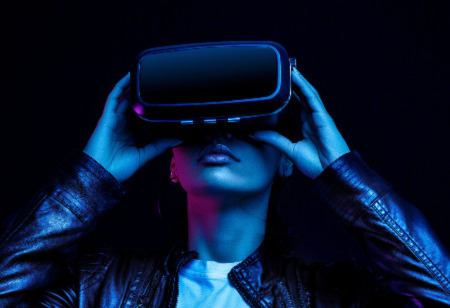
The Reality of How China is Leading the AR/VR Revolution


The development of affordable, comfortable, and powerful AR headsets is the focus of intense competition amongst the biggest names in consumer technology, including Apple, Microsoft, Sony, Meta, and Google. Chinese companies such as Oppo, Xiaomi, and Lenovo are also making progress in this area. A display manufacturer named TCL is also experimenting with wearable screens, such as a VR headset and mixed reality spectacles. Through the use of AR headsets, users may create immersive and interesting experiences by fusing digital material with reality. This showcases AR headsets or devices are emerging as the frontier in consumer tech.
According to International Data Corp, the average annual compound growth rate for the Chinese AR and VR market from 2022 to 2026 will be 43.8 percent, compared to 38.5 percent internationally. The survey indicates that spending on AR and VR in China is expected to reach $13.1 billion by 2026, making it the world's second-largest market. Over the same time span, global spending might increase to $74.7 billion in 2026.
Several Chinese businesses, including Xiaomi, Lenovo, and Oppo, demonstrated their progress in this field at the MWC exhibition, which got underway in late February. With that said, let’s look into the major Chinese manufacturers of AR/VR devices today.
Lenovo
ThinkReality is Lenovo's unique cloud-based platform enabling XR (AR/VR/MR) devices, applications, content, and services on a worldwide scale. The ThinkReality A3 smart glasses, designed for business users, were also recently presented by the company. They utilize Qualcomm's XR1 CPU and may link to PCs or smartphones through USB-C. They have two 1080p displays with support for mixed reality and the ability to display up to five virtual monitors. Additionally, the business is working on the ThinkReality VRX, a recently unveiled headgear that will be available in 2023 and offer lightning-fast 5G and WiFi 6 connectivity. It runs Android 12 and is powered by a Snapdragon XR2+ Gen 1 processor.
Xiaomi
Xiaomi is working on MR and AR headphones that could compete with the rumored Apple product. Xiaomi Wireless AR Glass Discovery Edition, a wireless AR headset that uses the Snapdragon XR2 Gen 1 Platform and MicroOLED displays, was displayed by the company at MWC. It provides low-latency communication, adaptive retinal displays, and hand-tracking interaction. It supports a variety of applications and can connect to smartphones that are Snapdragon Spaces ready. It contains electrochromic lenses and is just 126g in weight. With its success in the smartphone and smart home markets, Xiaomi is now aiming to take on other industry giants like Google, Microsoft, and Apple in the VR and AR market.
TCL
A screen for every reality is what TCL, a manufacturer of displays, wants to place in front of your eyes. The business unveiled its most recent wearable display experiments at CES 2023, including a VR headset and mixed-reality glasses. The NXTWear V VR headset is a portable design with a high-resolution and expansive field of view. A full-color Micro LED display is used in the company's RayNeo X2 mixed reality glasses, which displays heads-up information in the wearer's field of view. Later this year, TCL intends to make them accessible to consumers and developers.
Oppo
Oppo believes that mixed reality will overtake smartphones as the leading computing platform, and it wants to entice programmers to build mixed reality applications. Oppo recently unveiled its newest mixed reality headset, the Oppo MR Glass Developer Edition, at the Augmented World Expo (AWE) 2023. The headset is equipped with two color cameras that produce a realistic "through" view of the surroundings and is powered by Qualcomm's Snapdragon XR2 Plus CPU. Users can interact with the digital content using the ring controls that are included with the headset. The Oppo MR Glass Developer Edition is made for programmers who want to build apps and investigate the possibilities of XR technology.
Xreal
A pair of slim, light-weight glasses that resemble wayfarer sunglasses called the Nreal Air was recently launched by the Chinese manufacturer of augmented reality glasses, Xreal. They can create a 130-inch HD theater experience for watching movies, streaming, working, or gaming anywhere by connecting to compatible smartphones, tablets, or game consoles through USB-C. A set of slim, lightweight glasses that resemble wayfarer sunglasses called the Nreal Air was recently launched by a Chinese manufacturer of augmented reality eyewear. They can create a 130-inch HD theater experience for watching movies, streaming, working, or gaming anywhere by connecting to compatible smartphones, tablets, or game consoles through USB-C.
A Fierce Competitor
China is undoubtedly in an excellent position to take advantage of this growing demand as virtual reality (VR) and augmented reality (AR) continue to soar. This is made possible by its extensive commitment to accelerating the development and use of this technology throughout its consumer and commercial sectors.
The government's strong commitment to ensuring that new technologies such as virtual reality form a part of the country's new round of scientific and industrial revolution is certainly a crucial component of China's drive into VR/AR. This, in turn, not only implanted in the general public, investors, and companies a broad idea that VR/AR was cool, but also translated into a slew of practical actions.
Tech Giants Involvement
Aside from the government, VR/AR has piqued the interest of China's tech behemoths such as Alibaba, Baidu, Tencent, and mobile provider Xiaomi. Each has launched its own endeavors to advance the technology for a variety of applications, including as immersive video and gaming, mobile VR and online shopping, and mobile VR.
Given their manufacturing prowess and the existence of major players such as Lenovo, HTC Vive, Yi Technology, Xiaomi, Deepoon VR, Goertek, and Huawei, hardware development appears to be an area in which these businesses may succeed. As a result of its leading position in the development of 5G networks, which emphasize ultra-high-speed, low-latency, huge connections, ubiquitous networks, and low power consumption, Huawei, in particular, has the potential to substantially enhance the VR/AR experience.

